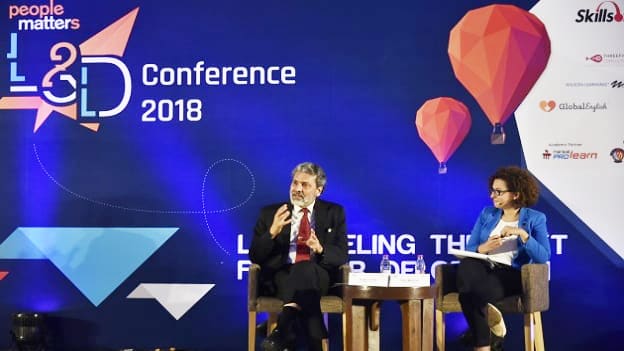5 key takeaways on the new learning paradigm – A CEO’s perspective

“We’re living at a time when we are bombarded with information and we are losing the ability to be mindful and to delve deeper,” says Rajeev Dubey, Group President (HR & Corporate Services) & CEO (After-Market Sector), Mahindra & Mahindra addressing a gathering of HR leaders at the People Matters L&D Conference 2018.
While in the previous decades, learning was viewed as an optional activity, we have now moved to a phase where learning is not just mandatory, it is a feature of work. Speaking about the state of learning in companies today, he said, “We are afraid to admit that we need to learn.” In this context, a leader’s job is to help unleash the potential of the employees by asking questions.
There is a need to be aware, to have a desire to learn and to be persistent.
Here are the key takeaways from the session:
- Need to focus on experience, not just education
There’s a disproportionate focus on education within the ‘70-20-10’ framework, which contributes just 10 percent of learning. While experience or on-the-job learning and exposure – which includes having access to mentors, coaching, peer learning etc., contribute to 90 percent of learning. L&D strategies should reflect on how to enable and track learning that is not delivered in the form of courses. - Stop looking at work and life as a dichotomy. Learn always
The dichotomy between work and life and its subsequent separation to learning is not helpful. Learning needs to be an exercise in every moment of life. There is a need to see learning in work and experience and vice versa. This approach helps deal with a number of blind spots that companies and L&D leaders struggle with. - VUCA + Employee pushback is a new normal
In a volatile, uncertain, complex and ambiguous world, employees are not going to learn anything without having meaningful reasons to do so. L&D professionals must shape their strategies with this idea in mind. The key is to be mindful of the fact that there needs to be a balance in priorities. - Reflection is a great feedback mechanism for learning
Giving the example of a leadership exercise, where senior leaders were trained to have reflective conversations with themselves, Rajeev highlighted that one can learn a lot by simply engaging in reflection. “Why are we doing what are doing?” and “What went wrong and how to make it better?” – These questions often serve as great starting points for useful learning. - It’s not profit vs. learning. It’s profit and learning
While a number of L&D leaders worry about how to map aspects like motivation to work and learning with bottom-line results. In a competitive business landscape, one can’t have one or the other. There is enough science to back up the claim that great business results are related to great people practices. The future of sustainable business practices is going to be determined by the impact on the people and the planet.
The end goal of L&D is to create sustained outperformance. In addition to strategy, structure, process, and metrics, you need to show that you care. Finding the right balance will be critical to companies that want to succeed. And while the journey will not always be smooth and there will be ups and downs, the key to strive on.












